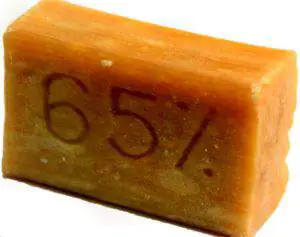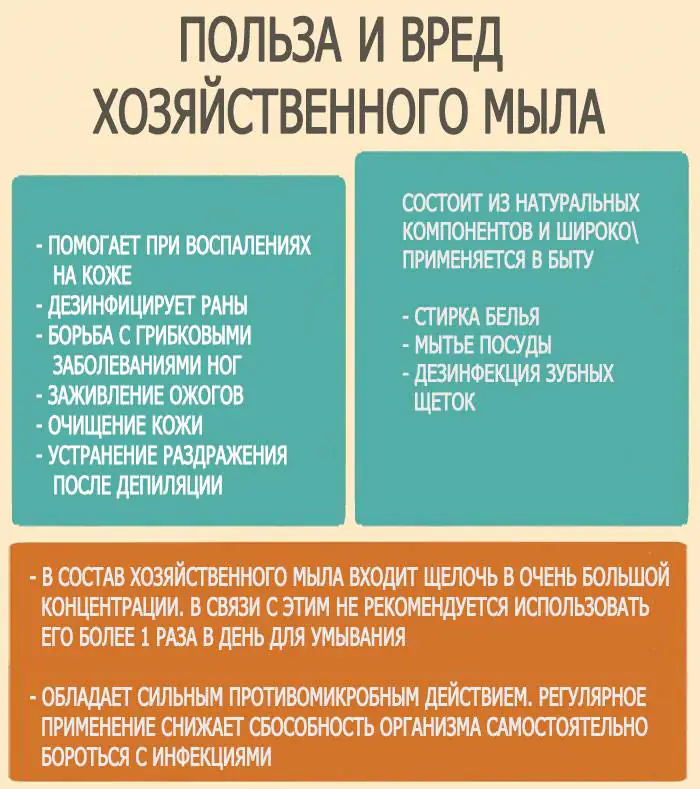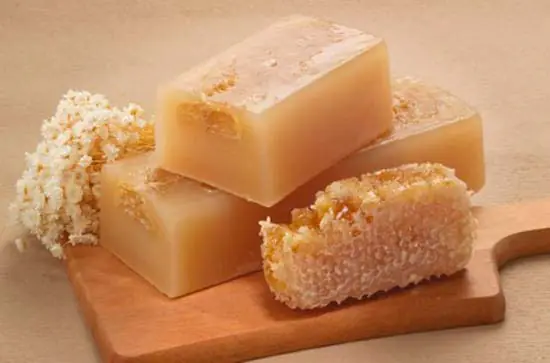In the time of our grandmothers, store shelves and pharmacy windows were not replete with cosmetics for problem skin.
And acne, as in our time, occurred in almost every person.
Therefore, simple improvised means were in use, because every girl and woman wanted to have clear facial skin.
- All information on the site is for informational purposes only and is NOT a guide to action!
- Can give you an ACCURATE DIAGNOSIS only DOCTOR!
- We kindly ask you NOT to self-medicate, but make an appointment with a specialist!
- Health to you and your loved ones!
One of these home methods for combating acne is laundry soap.
Nowadays, few people dare to expose their skin to it. And in vain.
After all, if you follow certain rules of use, laundry soap for acne can still be very effective.
Properties
We are accustomed to using laundry soap as the simplest and most inexpensive means for washing and cleaning various surfaces. Thanks to its alkaline composition, it perfectly dissolves the most severe contaminants and kills germs.
These same properties make it possible to use laundry soap against acne:
- antibacterial;
- disinfectant;
- sebum regulating;
- fat dissolving.
Compound
- The basis of laundry soap is vegetable and animal fats. They are heated by adding soda and boiled at high temperature for several days. The resulting solution is called soap glue in production. When cooled, it turns into a thick mass, which has from 40% to 75% fatty acids (depending on the category of soap - I, II or III). The higher the fatty acid content (that is, the higher the category), the more pronounced properties (especially detergent) the soap has.
- Laundry soap has a high hydrogen content - pH 11-12. For comparison, the pH of human skin fluctuates in the range of 4-6. Therefore, many are distrustful of the prospect of using it on the skin of the face.
Photo: the product contains only natural ingredients
- The solid bar of laundry soap has a completely natural composition, which still complies with GOST adopted many years ago. This cannot be said about soap produced by foreign companies. Although it foams better and has a pleasant smell, it contains synthetic components that can cause unwanted skin reactions, including allergic ones.
Now liquid laundry soap has also appeared on sale, which, of course, is much more convenient to use.
But it also cannot boast of a completely natural composition.
Therefore, if you decide to use laundry soap on your face and body to get rid of acne, then choose a dark bar with a fatty acid content of at least 72%.
Video: “Laundry soap for acne”
How it works
As already mentioned, soap has a pH of 11-12, which is almost twice as high as normal values for human skin.
A powerful alkaline environment is created on the surface, destructive for any microorganisms.
That is, one of the main causes of acne formation - bacterial infection - is thus completely eliminated.
If bacteria have already begun to multiply and lead to inflammation, they also die, and the inflammatory process itself begins to decline.
- This is how another important property of laundry soap manifests itself – anti-inflammatory.
- Another useful anti-acne property of laundry soap is its ability to dissolve fats.
That is, after treating the skin with this product, all fat plugs in the sebaceous ducts are completely destroyed, which ensures the full functioning of the sebaceous gland and prevents the appearance of a comedone, and therefore a pimple in its place.
How to use for acne
To understand whether laundry soap helps against acne, you should follow the rules for its use.
Otherwise, you can easily aggravate the situation without discovering the beneficial properties of this simple product.
The main question that causes most debate is whether it is possible to wash your face with laundry soap?
- Given its high pH, it should be understood that it will be very drying to the skin on the face and body. This means that if the skin is already dry and prone to flaking, it is better to refrain from such a procedure.
- But if you have oily skin, you still shouldn't include this product in your regular care routine. It is enough to wash your face 1-2 times a week.
Photo: before application, the soap is whipped into foam
Proper washing is carried out as follows:
- facial skin is cleansed of decorative cosmetics;
- It’s better if you lightly steam the skin by applying a hot towel, the pores will open and the cleansing will be deeper;
- the soap foams well in your hands or with a sponge;
- For application to the skin, only soap foam is used, it is scooped up with fingertips or a sponge and applied with massaging movements to the skin of the face, without touching the area around the eyes;
- The soap foam is thoroughly washed off with warm water; at the end of washing, you can lower its temperature so that the cleansed pores close.
For dry, combination skin or with single elements of acne, local application is recommended.
- You need to whip up a thick foam and apply it directly to the pimples. The active components will break down the sebaceous plug, disinfect the application area and reduce inflammation.
- For the best effect, you can leave the soap on for half an hour; sometimes it is recommended to leave it overnight.
To combat extensive rashes, a mask with laundry soap is recommended.
- All you need is water and table salt.
- A small piece of soap is crushed on a fine grater, diluted with warm water and whipped into a thick foam.
- Then the foam is combined with salt in equal proportions.
- This mass is applied to the face or other problem area for 20-30 minutes.
- Wash off first with warm, then cool water.
The mask can be performed 1-2 times a week. This procedure should not be carried out for more than a month.
Peeling with laundry soap helps remove blackheads on the face.
- It is recommended to steam the skin before the procedure.
- A cotton pad or sponge is well soaped and soda is poured on top.
Photo: peeling helps with acne and blackheads
- Areas with blackheads are treated with massaging movements. It is unacceptable to rub soda with force, as this will damage the skin.
- The procedure ends with washing.
After this, you can wipe the skin with a tonic - a weak solution of lemon juice or apple cider vinegar (1 teaspoon per glass of water).
For oily skin, a mask with onion juice will help a lot.
- A piece of laundry soap is finely rubbed, combined with a small amount of warm water and whipped into foam.
- Add a tablespoon of onion juice to it (you can simply grate the onion on a fine grater and measure out 1 tablespoon of the mass).
- The mixture is applied to the face and kept for about 10 minutes, during which it is recommended to take a comfortable position and close your eyes, since the irritating effect of onion phytoncides on their mucous membrane is possible.
- After the procedure, you should rinse your face well and apply a light moisturizer.
Folk recipes
There are several traditional ways to use laundry soap for acne.
- Moisten the edge of the block with water and lather the pimple thickly. Leave overnight. By morning the pimple will dry out and the inflammation will subside.
- A bath procedure helps with acne on the back and overall health of the body. Laundry soap is finely rubbed and soaked in a tub of hot water. A broom is lowered there, and then the whole body is patted with it, paying special attention to areas with rashes.
- For severe rashes, make a mask based on laundry soap. It is rubbed, a glass of hot water is added and heated over low heat until a homogeneous mass is formed. Add 1 tbsp to it. l. camphor alcohol and hydrogen peroxide, 15 drops of ammonia. Mix well and apply to face for 15 minutes. Wash off with warm water, wipe with tonic (1 teaspoon of apple or table vinegar per 1 liter of water).
Photo: if there are a lot of rashes, you can make a mask
- Once a week you can make a mask with hydrogen peroxide. Take 1 tsp. shavings of laundry soap, add 5 drops of a 3% peroxide solution. For ease of application, dilute with a small amount of warm water. Apply to skin for 3 minutes.
- Calcium chloride enhances the effect of laundry soap. It turns out to be an excellent peeling. The skin needs to be cleansed of impurities. The calcium chloride solution is applied using a cotton pad in three doses with a 5-minute break. Then the cotton pad is soaped and the face is treated with laundry soap until the dirt stops rolling off. The condition of the skin before and after the procedure is so different that you will want to repeat it more than once. But you shouldn’t do this kind of peeling too often; once every 2 weeks or a month is quite enough.
How to use safely
How to get rid of acne using laundry soap and not harm the skin?
What are the types of acne on the face? Find out here.
There are some rules that you can follow to protect your skin as much as possible:
- Soap should be used 2-3 times a week, and for those with dry skin, once will be enough;
- after treating the skin with this product, be sure to use a nourishing or moisturizing cream;
- to combat acne on the body, use soap instead of shower gel no more often than every other day;
- Every day you can treat with soap only those areas that require immediate treatment, but no more than 1 time per day;
- masks based on laundry soap severely dehydrate the skin, so they are made no more than once a week.
Is it true that laundry soap helps with acne?
Laundry soap has all the properties necessary to effectively fight acne.
It eliminates the main causes of clogged pores - increased oiliness of the skin, pollution and pathogenic bacteria.
But if acne is caused by internal diseases or abnormalities in the functioning of organs and systems (hormonal instability, poor diet, diseases of the digestive system, etc.), then using this remedy it will not be possible to prevent their reappearance.
Therefore, laundry soap can be considered a good symptomatic remedy, but the problem of rashes itself should be solved together with a doctor.
Advantages
Why should you try laundry soap for acne?
It has a number of advantages:
- its composition is completely natural, it does not contain surfactants (surface-active components that disrupt the structure of the skin);
- it's cheap, and therefore its use is available to everyone;
- destroys bacteria, which is very important in the fight against acne;
- perfectly removes a variety of contaminants and fat plugs;
- does not cause allergic reactions on the skin.
Flaws
But it cannot be denied that this tool has its drawbacks:
Photo: the product dries out the skin a lot
- Dries the skin a lot, leads to its dehydration;
- along with the fatty film, the natural protection of the epidermis is disrupted from external influences;
- along with pathogenic microflora, it also kills beneficial microorganisms, causing a disturbance in the bacterial balance on the skin.
To avoid negative effects on the condition of the epidermis, you should not regularly use laundry soap.
It is used occasionally to combat severe rashes or individual inflamed elements, following the rules of use.
Useful tips
Some tips may be useful when choosing and using laundry soap for facial skin:
Photo: only a high-quality product is suitable for treating acne
- When choosing laundry soap, pay attention to its quality (mark of compliance with GOST on the packaging, light brown color, uniformity of the block, indication of fatty acid content of at least 72%);
- do not use soap with a low percentage of fatty acids for cosmetic purposes (less than 70%), very light or, conversely, dark brown, with a non-uniform crumbling surface;
- do not treat your skin with soap, and whipped foam;
- always use nourishing or moisturizing agents along with laundry soap for skin;
- the drier or more sensitive the skin, the smaller its area can be treated using laundry soap.
Reviews
Does laundry soap help fight acne?
How to cure acne on the face at home? Find out here.
What do acne on the temples mean? Read on.
Laundry soap can easily cope with emerging acne due to its properties, but with its use the skin begins to need additional care, primarily moisturizing.
Therefore, this remedy should be used extremely carefully and irregularly.
Video: “Top 5 budget products for fighting acne”
Operating principle
After use, laundry soap creates an alkaline environment on the skin, destroying bacteria that cannot exist in it. Usually these bacteria cause skin rashes. But after washing with alkaline products, sebum also leaves the face. For this reason, the skin may become excessively dry. With the help of alkali, which is contained in soap, not only bacteria, germs, but also all the dirt accumulated during the day are removed.
So what is the essence of the action of laundry soap against acne on the face? The fight against acne occurs through 
breakdown of fats. The resulting pimple is (simplified) a plug consisting of sebum and microorganisms. Since the accumulation of sebum prevents the flow of air to the hair follicles, metabolic processes in them are disrupted. With the help of household soap, these plugs can be easily removed: subcutaneous fat is washed out and the functioning of the glands is normalized.
Household soap will help you forget about the mechanical method of removing acne. Using it, you can easily and safely eliminate skin inflammation without damaging the walls of the hair follicle. After the procedures, the infection does not spread to healthy areas of the epidermis, acne disappears without leaving scars. Soap is not addictive, unlike drugs with antibiotics.
The disadvantages include undesirable consequences in the form of dryness and tightness.
Important!
In order to get rid of acne and not harm the body, you need to adhere to the following rules:
- It is not recommended to wash your face more than once a week. Is it possible to wash your face with laundry soap every day? Only spot application is allowed daily.
- After washing, it is recommended to moisturize your face (foams, creams);
- To reduce sebum secretion, it is recommended to use masks. For people with sensitive skin, cosmetologists recommend local use. But for those who have dry skin, it is better not to use it at all.

How to use?
Ways to use household soap to combat skin rashes:
- Washing. It is an effective method of cleansing the skin from dust, impurities and microorganisms.
- Local application to inflammatory areas. This method is ideal for combating rashes on thin, sensitive skin. Applied directly to the affected areas of the dermis, the soap dries out acne, breaks down sebaceous plugs, and prevents the appearance of new inflammations.
- Application in the form of masks. To prepare a mask from laundry soap, we will need: a medium-sized container, salt, warm water, and 1/4 of a bar of soap.
- Grate the soap (slightly cooled).
- Add water.
- Beat the mixture vigorously until foamy.
- Mix foam with salt (1:1).
- The resulting mask is placed on the face and left for 30 minutes, then washed off with water.
It is recommended to perform the procedure no more than every other day for a month.
If the skin is too oily, it is recommended to use a mask with the addition of onion juice.
- To prepare this mask, you need to finely grate a small bar of soap and dissolve it in warm water.
- Stir the resulting mixture and let it sit for 5 minutes.
- Pour 1 tbsp into the infused mixture. onion juice and beat into foam, which is then spread in a thick layer on your face. Keep for 10-15 minutes.
- Then just wash your face.
This mask helps open the pores by penetrating them, which is why a slight burning sensation may occur. After the procedure, to speed up the regeneration process, it is recommended to massage and then apply a protective day cream.
In addition to household soap, to prevent excessive drying of the epidermis, you can prepare a mask with the addition of sea buckthorn oil. It has anti-inflammatory, astringent and regenerating properties, and prevents the spread of ulcers.
Benefits of Soap
- The composition contains only natural ingredients.
- after washing, all microbes are destroyed, since an alkaline environment remains on the skin.
- Effectively removes dust, grease and germs.
Using household soap is absolutely safe and will help you get rid of acne quickly.
A universal remedy for acne, blackheads and wrinkles

Hello, dear readers! Have you ever heard from your grandmothers about the benefits of laundry soap? In Soviet times, almost every housewife used it as a detergent and cleaning agent. But not only!
Women used it for cosmetic purposes to treat acne, wrinkles and a number of other skin problems, but for me the benefits of laundry soap for the face are obvious, since I have personally tried its effect on myself.
Useful properties of household products
The main advantage of a budget cosmetic product is its natural composition. It consists largely of fats (65-72%) and alkalis (0.15-0.20%) and does not contain harmful additives, fragrances, dyes, sulfates and parabens.

Important! Laundry soap gently cleanses the skin and removes the stratum corneum of the epithelium without damaging it. Highly valued for its antibacterial properties.
Every year the environmental situation in the world is worsening, which also affects our epithelium. This universal remedy is ideal for treating skin lesions, as it breaks down fats and cleanses pores. It is shown when:
- pimples, acne;
- wounds after squeezing out pimples;
- inflammation;
- shallow wrinkles;
- post-acne.
Soap performs a regenerative function and “grows” new cells in damaged areas. After using it, your face may feel tight and dry. This happens because the protective fat layer is erased from the surface of the skin. Therefore, after cosmetic procedures you should moisturize your face with cream.
Before using this hygiene product as a “doctor” for acne on the face, make sure it is hypoallergenic for your skin type. Those with dry epidermis are recommended to use the product once a week, and those with oily skin – two to three times.
The classic method of treating acne is to use soap suds or a solution of a household bar. This is the easiest and fastest way to get rid of unpleasant skin lesions.
You should lubricate the affected areas with a soap solution. At the end of the procedure, the remaining product must be washed off with warm water, then rinsed with cold water to close the pores.
It is recommended to add this universal household product to scrubbing face masks. Here are some of the most accessible recipes:
- Mix soap shavings with water, add half a teaspoon of baking soda and achieve a thick consistency. Apply the paste to your face for 25-30 minutes, then rinse off the residue with water.
- Dilute one tablespoon of soap with 80 ml of warm boiled water, add a spoonful of onion juice, mix all ingredients and apply the mask to the face for a quarter of an hour. After this procedure, you should wipe the affected areas with ice cubes from a decoction of medicinal chamomile.
- Mix 30g of the bar with one teaspoon of hydrogen peroxide, beat until foam forms and apply to acne. Keep for no more than 5 minutes. Before using the mask, wipe the affected areas with aloe pulp.
To be convinced of the benefits of laundry soap for the face, I provide reviews from those who have tested the product on themselves and achieved a positive result:
Olga, 24 years old: “I like to experiment, try new drugs and prepare different masks. But what I will never exchange for other products is laundry soap. I use it in its pure form to treat acne on my face, after which once a week is enough for me to maintain results.”

Ilya, 21 years old: “Laundry soap helped cure allergic acne. The product dries out the skin a little, but this is the only method that helped me cleanse the affected areas on my face.”
Don't be upset if you have blackheads on your face. A budget method for cleaning pores, which I will be happy to share with you, will help you forget about them once and for all. To prepare the mask, prepare the following ingredients:
- basics 72%;
- table or sea salt - 1 tsp;
- decoction of calendula and chamomile inflorescences - 0.5 tbsp.
Grate a piece of brown bar and dissolve in a vegetable decoction. Add salt and wait until it is completely dissolved. Apply the finished composition to your face, and after 10 minutes, wash with warm water. This mask can be used no more than twice a week.
Many readers, of course, are interested in the question of whether it is safe to use soap to treat skin defects on the face. Dermatologist Oksana, whose experience in the profession is 16 years, knows this for sure.
She writes: “I am not against traditional medicine and “grandmother’s” methods of treating acne. Over the years of practice, I have become convinced that sometimes expensive medications do not bring the expected effect, while using cheap, proven remedies can get the desired result. I do not exclude laundry soap from the list of means for cleansing the epithelium of acne, pimples and blackheads. The main thing is to know when to stop so as not to harm the skin.”
One of the properties for which women value this household product is the smoothing of the facial epithelium. A mask based on 72% of the product will help remove fine wrinkles:
- prepare a foam solution;
- add to it the beaten whites of two eggs and a few teaspoons of liquid honey;
- thicken the mass with two tablespoons of finely ground oatmeal;
- add two or three drops of aromatic peach oil;
- Leave the mask on the affected area for 20 minutes, then rinse with warm water.
The recipe is suitable for treating the epithelium of the face, neck and décolleté. Use the mask 2 times a week.
Laundry soap with sea salt is an excellent remedy not only for small and large blackheads, but also for cleansing the epithelium of dead particles. To prepare a cleansing mask, mix brown foam 72% bar and 1 teaspoon of fine-grained sea salt. Cover the entire face area with the mixture and leave for 20 minutes.

Rinse off only with warm water, then wash under running cold water or use ice cubes from a decoction of calendula and chamomile inflorescences. It is enough to do the mask once a week.
Thanks to its composition and antibacterial properties, laundry soap will help get rid of skin lesions on the face, dirty pores and fine wrinkles, if you use it wisely and do not forget about precautions. If you have the slightest doubt, consult your dermatologist or cosmetologist before starting therapy. Thank you all for your attention!



